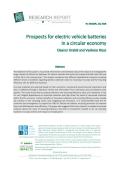The Climate Investment Funds (CIF) Administrative Unit, in collaboration with the CIF’s multilateral development bank (MDB) partners, sought to undertake an analytical exercise to draw lessons from the experience of the CIF and international finance institutions in supporting investment in energy efficiency. The aim of this study, Lessons from the Experience in Scaling-Up Energy Efficiency: Synthesis report was to better understand the effective use of public finance – in particular, concessional climate finance provided through the CIF – in scaling up investment in energy efficiency, mainly in middle-income countries, focussing specifically on demand-side energy efficiency.
The Climate Investment Funds (CIF) Administrative Unit, in collaboration with the CIF’s multilateral development bank (MDB) partners, sought to undertake an analytical exercise to draw lessons from the experience of the CIF and international finance institutions in supporting investment in energy efficiency. The aim of this study, Lessons from the Experience in Scaling-Up Energy Efficiency: Case study report was to better understand the effective use of public finance – in particular, concessional climate finance provided through the CIF – in scaling up investment in energy efficiency, mainly in middle-income countries, focussing specifically on demand-side energy efficiency.

The objective of this paper is to provide information and estimates about the impacts of managing the large number of lithium-ion batteries for electric vehicles that enter the market and will reach the end of their life in the coming years. The analysis compares two different hypothetical scenarios involving different levels of ambition regarding battery collection rates for recycling in Europe and the recycling efficiency rate for different materials.

This report, undertaken within the framework of the OECD Champion Mayors for Inclusive Growth initiative, assesses inclusive growth trends and challenges in the Seoul metropolitan area. The analysis goes beyond income to assess the barriers faced by specific groups - non-regular workers, youth, women, the elderly and migrants - across four dimensions: education, labour market, housing and the urban environment, and infrastructure and public services. The study then takes a closer look at two major policy efforts by the Seoul Metropolitan Government to advance inclusive growth. The study analyses the city’s efforts to ensure that strategies to address climate change also protect and benefit the most vulnerable populations, notably through the Promise of Seoul, which puts citizen welfare and social inclusion at the heart of the city’s efforts to tackle climate change. The study also assesses the efforts of city authorities to level the playing field for small firms and entrepreneurs through its Economic Democratisation Agenda.

